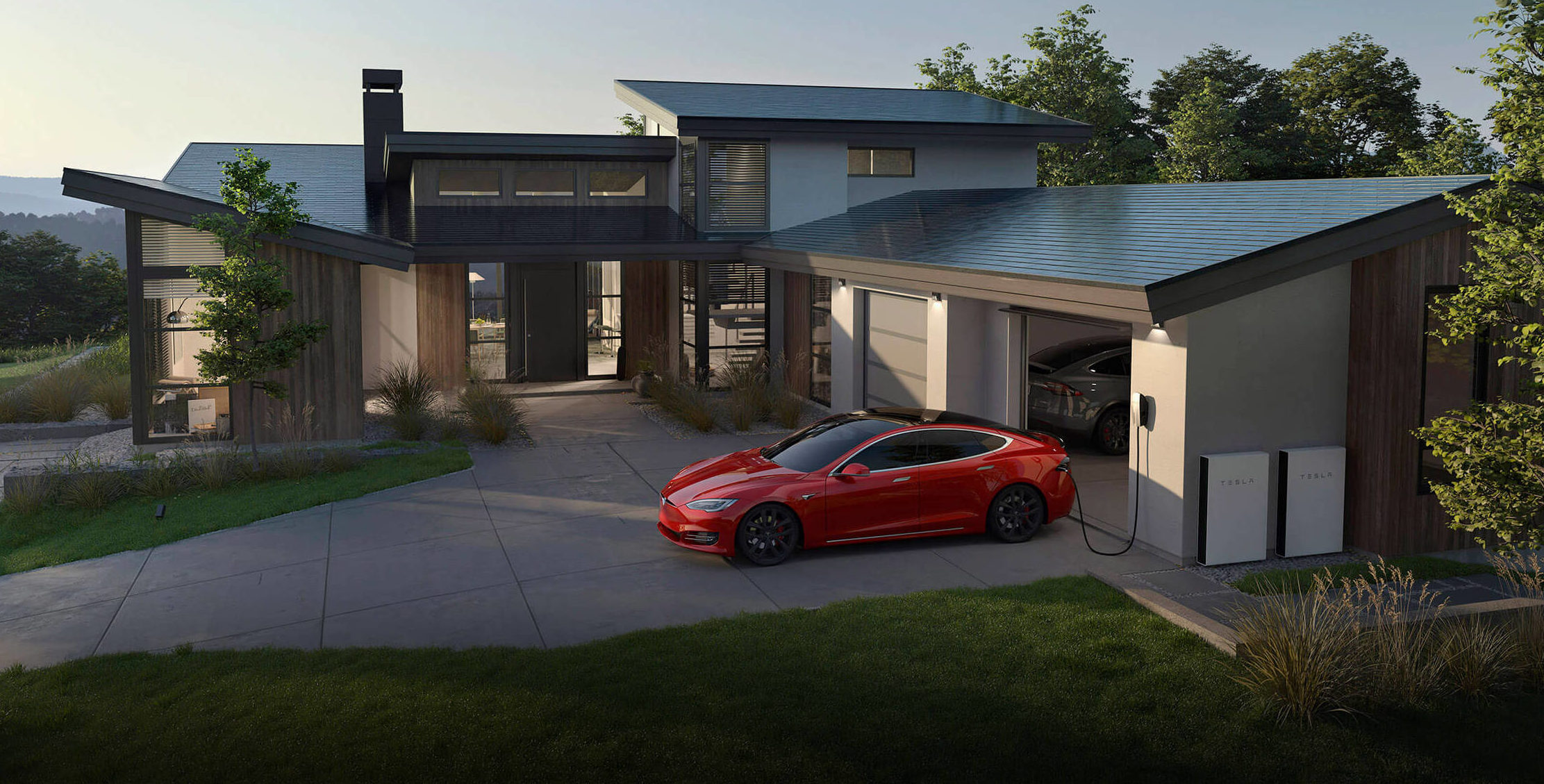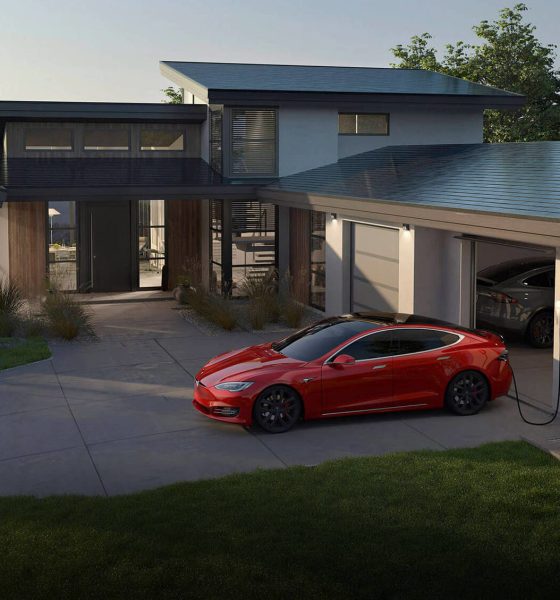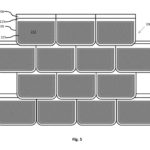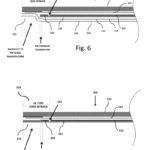

Energy
Tesla patent hints at system that makes Solar Roof tiles look even better
While Tesla’s Solar Roof tiles are already being installed on the homes of first customers in the United States, the shingles themselves are still in initial production. Unveiled back in October 2016, the Solar Roof tiles are expected hit larger production volumes this year. As the company heads into yet another ramp of a potentially disruptive product, though, Tesla appears to be working on some improvements on the tiles’ design as well.
As noted in a recently published patent application, Tesla is developing a system that would allow the company to improve the aesthetics of the solar shingles even further. In the patent application’s description, Tesla noted that integrated photovoltaic (BIPV) roofing systems such as the Solar Roof tiles are becoming more popular in the residential solar market, thanks to their benefits in both function and design. That said, while BIPV systems present an excellent solution for design-conscious customers, the system itself faces some challenges — the most notable of which is visual uniformity.
Tesla notes that in prior art BIPV roofing systems, the active solar portions of a roofing module end up being visibly different in appearance compared to inactive parts of the roof. The company notes that this contrast in appearance can get so pronounced that it becomes easy to spot which tiles are active and which are inactive from road level. Tesla notes that even in the design of the shingles themselves, it is quite easy to determine which parts of the tiles are active and which ones are not.
“This problem of visual mismatch, however, is not limited to BIPV versus non-BIPV sections of the roof. Even within a single roof tile and/or BIPV roofing module, the solar cells or active solar regions are clearly distinguishable from the other surrounding materials. This is due in part to edge setback constraints that impose a fixed, non-active edge border around active solar portions of solar roof tiles or BIPV roofing modules. Therefore, there exists a need for a solar roof tile or BIPV roofing module that ameliorates deficiencies of prior art BIPV roofing systems,” Tesla wrote.
- Tesla’s solar shingle design outlined in its recent patent application. (Photo: US Patent Office)
- Tesla’s solar shingle design outlined in its recent patent application. (Photo: US Patent Office)
The design of Tesla’s solar shingles outlined in its recent patent application. (Photo: US Patent Office)
Tesla explains this design issue for BIPV roofing systems more extensively in the section below.
“In either tile 105 of FIG. 2 or tile 106 of FIG. 3, the lack of active thin-film material within the edge setback results in a relatively large, e.g. ˜16 mm, visible border around the outside of active area 112 that is noticeable not only when viewed up close, but even at street level distances from a roof surface. This result can be seen in the extended partial array 100 of FIG. 4. The relatively large percentage of tile surface area of the edge setback that is devoid of thin-film material creates a sharply contrasting two-color/two-tone pattern between the area surrounding the active area of thin-film photovoltaic material and the active area of thin-film photovoltaic material. In embodiments, techniques are used to provide aesthetic uniformity such as depositing colored material on the underside of top glass 110 prior to lamination to conceal active area 112 beneath. This approach, however, may result in a reduction in energy collection because these extra materials may block photons from reaching active area 112.”
Tesla’s solution for this aesthetic challenge — which uses an inactive area of thin-film photovoltaic material that surrounds a solar shingles’ active area — is simple and clever. Tesla describes its design in the section below.
“As shown, the tiles 205 include a substantially rectangular active 212 surrounded by a substantially rectangular board of an inactive area 225. In embodiments, the inactive area may completely surround the active area or may only be present on one, two or three sides of the active area. As shown in FIG. 5, the tiles 205 create a more uniform look and, when viewed at distances, such as in shown in FIG. 8, adhesion area 215 blends into the natural seams between adjacent tiles or between active areas 212 of adjacent tile sections. The visible material difference has been attenuated by the use of non-active thin-film material within a portion of the setback region allowing for a smaller adhesion zone.”
Tesla’s recent patent application would be particularly useful for the other Solar Roof variants planned by the company. So far, social media posts from Solar Roof owners show homes fitted with the company’s Textured tiles, whose design inherently bypasses the uniformity issues described in the patent application. As for other Solar Roof variants like Smooth and Tuscan, though, the recent application’s innovations would certainly be beneficial.
Tesla’s Solar Roof tiles are being produced at Gigafactory 2 in Buffalo, NY. Over the years, the facility has largely evaded attention, particularly as Tesla’s energy business was mostly overshadowed by the company’s ramp for the Model 3. Last year, though, Tesla opened the doors of Gigafactory 2 to the media, providing a glimpse of what is in store for the company’s residential solar business. While Tesla did not provide specifics on the facility’s current output, the electric car and energy company did state that Gigafactory 2 is operating 24/7, and that the long waiting list for the Solar Roof tiles would likely keep the entire facility busy for years.

Cybertruck
Tesla updates Cybertruck owners about key Powershare feature

Tesla is updating Cybertruck owners on its timeline of a massive feature that has yet to ship: Powershare with Powerwall.
Powershare is a bidirectional charging feature exclusive to Cybertruck, which allows the vehicle’s battery to act as a portable power source for homes, appliances, tools, other EVs, and more. It was announced in late 2023 as part of Tesla’s push into vehicle-to-everything energy sharing, and acting as a giant portable charger is the main advantage, as it can provide backup power during outages.
Cybertruck’s Powershare system supports both vehicle-to-load (V2L) and vehicle-to-home (V2H), making it flexible and well-rounded for a variety of applications.
However, even though the feature was promised with Cybertruck, it has yet to be shipped to vehicles. Tesla communicated with owners through email recently regarding Powershare with Powerwall, which essentially has the pickup act as an extended battery.
Powerwall discharge would be prioritized before tapping into the truck’s larger pack.
However, Tesla is still working on getting the feature out to owners, an email said:
“We’re writing to let you know that the Powershare with Powerwall feature is still in development and is now scheduled for release in mid-2026.
This new release date gives us additional time to design and test this feature, ensuring its ability to communicate and optimize energy sharing between your vehicle and many configurations and generations of Powerwall. We are also using this time to develop additional Powershare features that will help us continue to accelerate the world’s transition to sustainable energy.”
Owners have expressed some real disappointment in Tesla’s continuous delays in releasing the feature, as it was expected to be released by late 2024, but now has been pushed back several times to mid-2026, according to the email.
Foundation Series Cybertruck buyers paid extra, expecting the feature to be rolled out with their vehicle upon pickup.
Cybertruck’s Lead Engineer, Wes Morrill, even commented on the holdup:
As a Cybertruck owner who also has Powerwall, I empathize with the disappointed comments.
To their credit, the team has delivered powershare functionality to Cybertruck customers who otherwise have no backup with development of the powershare gateway. As well as those with solar…
— Wes (@wmorrill3) December 12, 2025
He said that “it turned out to be much harder than anticipated to make powershare work seamlessly with existing Powerwalls through existing wall connectors. Two grid-forming devices need to negotiate who will form and who will follow, depending on the state of charge of each, and they need to do this without a network and through multiple generations of hardware, and test and validate this process through rigorous certifications to ensure grid safety.”
It’s nice to see the transparency, but it is justified for some Cybertruck owners to feel like they’ve been bait-and-switched.
Energy
Tesla starts hiring efforts for Texas Megafactory
Tesla’s Brookshire site is expected to produce 10,000 Megapacks annually, equal to 40 gigawatt hours of energy storage.

Tesla has officially begun hiring for its new $200 million Megafactory in Brookshire, Texas, a manufacturing hub expected to employ 1,500 people by 2028. The facility, which will build Tesla’s grid-scale Megapack batteries, is part of the company’s growing energy storage footprint.
Tesla’s hiring efforts for the Texas Megafactory are hinted at by the job openings currently active on the company’s Careers website.
Tesla’s Texas Megafactory
Tesla’s Brookshire site is expected to produce 10,000 Megapacks annually, equal to 40 gigawatt hours of energy storage, similar to the Lathrop Megafactory in California. Tesla’s Careers website currently lists over 30 job openings for the site, from engineers, welders, and project managers. Each of the openings is listed for Brookshire, Texas.
The company has leased two buildings in Empire West Business Park, with over $194 million in combined property and equipment investment. Tesla’s agreement with Waller County includes a 60% property tax abatement, contingent on meeting employment benchmarks: 375 jobs by 2026, 750 by 2027, and 1,500 by 2028, as noted in a report from the Houston Business Journal. Tesla is required to employ at least 1,500 workers in the facility through the rest of the 10-year abatement period.
Tesla’s clean energy boom
City officials have stated that Tesla’s arrival marks a turning point for the Texas city, as it highlights a shift from logistics to advanced clean energy manufacturing. Ramiro Bautista from Brookshire’s economic development office, highlighted this in a comment to the Journal.
“(Tesla) has great-paying jobs. Not just that, but the advanced manufacturing (and) clean energy is coming to the area,” he said. “So it’s not just your normal logistics manufacturing. This is advanced manufacturing coming to this area, and this brings a different type of job and investment into the local economy.”
Energy
Tesla and Samsung SDI in talks over new US battery storage deal: report
The update was related by industry sources and initially reported by South Korean news outlets.

Recent reports have suggested that Tesla and Samsung SDI are in talks over a potential partnership to supply batteries for large-scale energy storage systems (ESS).
The update was related by industry sources and initially reported by South Korean news outlets.
ESS batteries to be built at Samsung’s Indiana plant
As noted in a report from Korea JoongAng Daily, the demand for energy storage systems has been growing rapidly in North America, thanks in no small part to the surge in AI investments across numerous companies. With this in mind, Tesla has reportedly approached Samsung SDI about a potential battery supply deal.
The deal is reportedly worth over 3 trillion Korean won (approximately $2.11 billion) and will span three years, according to The Korea Global Economic Daily. A battery supply deal with Samsung SDI could make sense for Tesla as the company already has a grid-scale battery, the Megapack, which is perfect for industrial use. Samsung SDI could simply supply cells for the EV maker.
Production of the batteries would reportedly take place at Samsung SDI’s joint venture factory with Stellantis in Indiana, which is currently under construction. Samsung SDI recently announced plans to use part of that plant’s EV lines to produce cells for ESS, with a targeted capacity of 30 GWh by the end of next year.
Tesla and Samsung’s partnership
At present, only a handful of manufacturers, including Korea’s LG Energy Solution, Samsung SDI, SK On, and Japan’s Panasonic, are capable of producing energy storage-scale batteries domestically in the United States. A Samsung SDI official issued a comment about the matter, stating, “Nothing has been finalized regarding cooperation with Tesla.”
The possible energy storage system deal adds another layer to Tesla’s growing collaboration with Samsung, which is already in line as a partner in the upcoming production of Tesla’s AI5 and AI6 chips. Early sample manufacturing of the AI6 is expected to begin in South Korea, with mass production slated for Samsung’s Texas-based Taylor foundry when it starts operations.
The AI6 chip will power Tesla’s next wave of high-volume projects, including the Optimus humanoid robot and the autonomous Cybercab service. Musk has called the partnership with Samsung a “real collaboration,” adding that he personally plans to “walk the line” at the Taylor facility to speed up progress.










